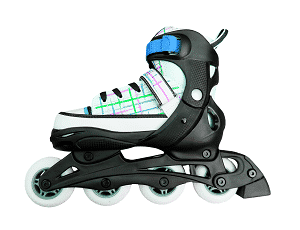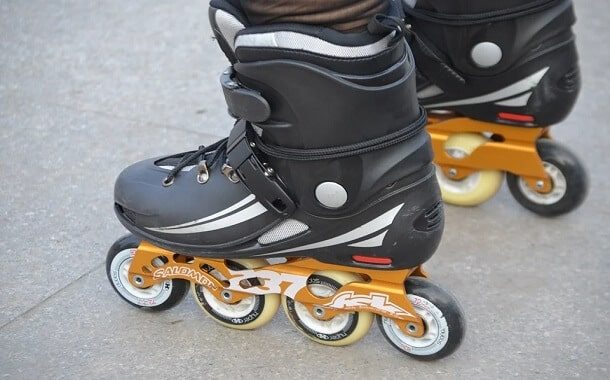How Much Do Rollerblades Cost?
Last Updated on February 23, 2024
Written by CPA Alec Pow | Content Reviewed by ![]() CFA Alexander Popinker
CFA Alexander Popinker
Rollerblading is a fun and exciting way to stay active and fit. But before you lace up and take off, an important question arises – how much will a decent pair set you back? Like most sports gear, rollerblade prices can vary widely based on your needs, experience level, and budget. This guide will break down the average costs and pricing factors so you can make an informed decision.
Highlights
- Basic recreational skates cost $60 – $150
- Intermediate urban and fitness skates run 150 – $300
- Advanced aggressive and speed skates range from $300 – $600+
- Prices are influenced by wheels, bearings, materials, and brand reputation.
- Consider buying second-hand, waiting for sales, and budgeting for maintenance.
- Invest in safety gear, and prioritize quality over low prices.
How Much Do Rollerblades Cost?
For basic recreational skates suitable for beginners or casual bladers, expect to pay $60 to $150. These provide adequate features for rolling around the neighborhood or boardwalk.
Mid-range fitness and urban skates cost $150 to $300. They have better wheels, bearings, and often brakes for more versatility. Great for hitting the skate park on weekends.
High-end aggressive or speed skates run $300 to $600+. Made with premium materials and performance components, they cater to competitive athletes.
Of course, you can always pay less by buying used rollerblades or renting. Or pay more for fully customized, pro-level pairs. But in general, these price ranges cover most needs. Keep reading as we explore the details.
Amazon features numerous rollerblade models with prices varying according to brand, style, and features. Prices range from under $100 to over $300.
Flying Eagle Skates offers a variety of rollerblades with prices ranging from $171.98 to $410.00, depending on the model and features.
Prices for Different Types of Rollerblades
Rollerblades come in many styles for different purposes. Let’s compare the costs.
Beginner Recreational Blades
$50 – $150
Great for newbies and casual skating, beginner skates focus on stability, comfort and value. Expect basic plastic frames with smaller wheels (70-80mm) and mid-grade components. Brands like Rollerblade, K2, and Roces offer solid options under $100.
Intermediate Urban and Fitness Blades
$150 – $250
Step up to larger wheels (80-90mm), better bearings, and more supportive boots. Powerslide, Rollerblade, and Roces models in this range are ideal for skating longer distances, picking up speed, and mastering tricks.
Advanced Aggressive and Speed Skates
$250 – $600
Serious bladers need strong, responsive skates to handle intense athletic moves. Race-ready speed skates have 100-110mm wheels and precision bearings for maximum velocity. Aggressive skates are ultra-sturdy for jumping and grinding. Expect to pay over $300 for these elite pairs.
Kids’ Skates
$50 – $150
Children’s skates cost less than adult sizes since they’re smaller and have fewer features. Adjustable sizing allows room to grow. Models from Rollerblade and K2 offer great value for young beginners.
As you move up in experience level, the prices rise accordingly. Extra performance comes at a cost. But investing in the right skates prevents injuries and won’t hinder your progression.
What Factors Influence the Cost?
Several key components determine the price when shopping for rollerblades.
Materials and Build Quality – Cheaper recreational skates have plastic frames, while higher-end models use composite, carbon fiber or aluminum for rigidity and responsiveness. The boot material affects support and durability – vinyl, soft, and hard boots range from entry-level to pro-grade. Premium stitching and cuff padding add comfort and ankle support.
You might also like our articles about the cost of ski equipment, a skateboard, or a bobsled.
Wheel Size and Bearings – Larger wheels provide faster rolling and a smoother ride. Beginner skates usually have 70-80mm wheels, while advanced fitness and speed skates boast 100-110mm wheels. Higher quality bearings (rated ABEC 7-9) also enhance speed.
Frame and Closures – Advanced frames are lighter while still providing stiffness and shock absorption. Secure closure systems like laces, buckles, and ratchet straps ensure a tight, customized fit for active skating.
Brand and Reputation – Established companies like Rollerblade, Powerslide, and Roces command higher prices thanks to track records of quality, innovation, and high-performance technology.
Smart Shopping Tips for Rollerblades
 Follow this advice to get great value on any budget.
Follow this advice to get great value on any budget.
Buy Online or In-Store? – Online shops like Inline Warehouse and SkatePro offer wider selections and discounts. Local sporting goods stores allow trying skates on for fit. Check both to compare prices and options.
Consider Second-Hand – Used skates can provide huge savings, especially for growing kids. Try apps like Letgo, and websites like Craigslist, or check Play It Again Sports. Just ensure they’re in good condition.
Wait for Discounts and Sales – Retailers offer promotions during off-peak seasons. Look for sales in winter or early spring before summer skating picks up again. Sign up for email lists to receive discount alerts.
Factor in Protective Gear – Don’t neglect safety – wrist guards, knee/elbow pads, and helmets are a must, especially for beginners. Triple8 and Pro-Tec make quality, affordable protective gear.
Prioritize Quality Over Cost – Cheaper skates may seem appealing, but low-end pairs offer less comfort, safety, and durability. Investing a little more upfront prevents injuries and lasts longer through regular use.
Ongoing Cost Considerations
The initial purchase isn’t the only expense for rollerbladers. Here are some additional costs to factor in.
Maintenance and Repairs
Clean off dirt, lubricate wheels and bearings, and check for loose screws to extend your skates’ lifespan. Eventually, wheels and parts will need replacing – frequent skaters should budget $50-100 per year.
Replacement Parts
Wheels, bearings, laces, liners, and other components wear down over time. Replacing just what’s needed is cheaper than new skates. Shop parts online at Rollerblade.com, OakCitySkate, or The-house.com.
Warranty Coverage
Quality rollerblades come with at least a 1 year manufacturer’s warranty against defects. This protects your investment – be sure to register your skates online!
Final Words
Rollerblading is an exciting sport that can be enjoyed at any budget. Determining your experience level, skating style, and needs will help narrow down your options. Shop smartly and enjoy the open road on wheels!
Frequently Asked Questions
Is rollerblading painful?
Like any new sport, rollerblading may involve some aches and discomfort as your feet and leg muscles adjust. However, with the right setup and techniques, rollerblading can be thrilling without excessive pain:
- Choose supportive, well-fitting skates that align properly with your feet. This prevents rubbing, blisters, and foot fatigue.
- Wear protective padding and fall safely to avoid cuts, bruises, and injuries. Falling backwards and rolling is better than trying to catch yourself.
- Build strength in your core and lower body with off-skate conditioning. This stabilizes your ankles, knees, and hips for better control.
- Maintain proper posture, bend your knees, and avoid locking your legs. This allows you to absorb bumps and maintain balance.
- Take breaks and build mileage gradually as your body adapts. Ease into more intense skating over time.
- Consult with an instructor to ensure you’re using proper techniques to stay in control. This avoids pain from overexertion.
With patience and practice, rollerblading transitions from painful to pleasurable as your confidence grows!
Does rollerblading tone your body?
Absolutely! Rollerblading is a full-body workout that engages your core and lower body in particular:
- Maintaining balance and controlling your skates works the core, back, abs, and glutes.
- Striding and pushing off the blades tones the quadriceps, hamstrings, hips, and calves.
- Stopping and maneuvering puts emphasis on stability and control, working smaller intrinsic muscles.
- Higher-intensity skating, tricks, or hill climbs burn more calories to strengthen and tone muscles faster.
In addition to the aerobic benefits, rollerblading builds lower body strength to balance on an unstable surface. Skating targets muscles that cycling, running, and walking often miss. The variation prevents overuse injuries. Just 30-60 minutes of skating multiple times per week will boost muscle tone, balance, and coordination.
Is rollerblading a real sport?
Rollerblading absolutely qualifies as a real competitive sport, just like ice skating. Some examples include:
- Speed skating – Elite skaters race 100m, 300m, and longer distances for medals and world records, reaching speeds over 50 mph!
- Downhill skating – Races down curvy, steep hills at high speeds require nerves of steel.
- Aggressive street skating – Tricks like rail slides, stairs, and ramp jumps push athleticism and creativity.
- Roller derby – A full contact team sport on quad skates with speed, strategy and physical endurance.
- Artistic figure skating – Individuals and pairs perform leaps, spins and footwork routines with grace and precision.
- Hockey – Played on inline skates with similar rules to ice hockey. Very fast and physical.
With national associations, pro competitions, sponsorships, and dedicated training facilities, rollerblading ranks among other seriously competitive sports for talented athletes worldwide.


Leave a Reply
Want to join the discussion?Feel free to contribute!